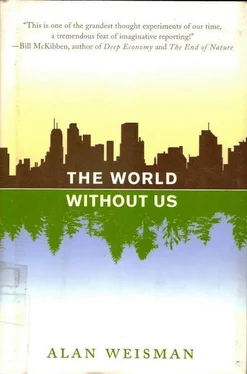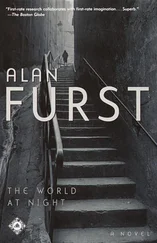As it happens, that will be the key to breaching Manhattan’s hard shell if nature sets about dismantling it. It would begin very quickly, with the first strike at the city’s most vulnerable spot: its underbelly.
New York City Transit’s Paul Schuber and Peter Briffa, superintendent of Hydraulics and level one maintenance supervisor of Hydraulics Emergency Response, respectively, understand perfectly how this would work. Every day, they must keep 13 million gallons of water from overpowering New York’s subway tunnels.
“That’s just the water that’s already underground,” notes Schuber.
“When it rains, the amount is…” Briffa shows his palms, surrendering. “It’s incalculable.”
Maybe not actually incalculable, but it doesn’t rain any less now than before the city was built. Once, Manhattan was 27 square miles of porous ground interlaced with living roots that siphoned the 47.2 inches of average annual rainfall up trees and into meadow grasses, which drank their fill and exhaled the rest back into the atmosphere. Whatever the roots didn’t take settled into the island’s water table. In places, it surfaced in lakes and marshes, with the excess draining off to the ocean via those 40 streams—which now lie trapped beneath concrete and asphalt.
Today, because there’s little soil to absorb rainfall or vegetation to transpire it, and because buildings block sunlight from evaporating it, rain collects in puddles or follows gravity down sewers—or it flows into subway vents, adding to the water already down there. Below 131st Street and Lenox Avenue, for example, a rising underground river is corroding the bottom of the A, B, C, and D subway lines. Constantly, men in reflective vests and denim rough-outs like Schuber’s and Briffa’s are clambering around beneath the city to deal with the fact that under New York, groundwater is always rising.
Whenever it rains hard, sewers clog with storm debris—the number of plastic garbage bags adrift in the world’s cities may truly exceed calculation—and the water, needing to go somewhere, plops down the nearest subway stairs. Add a nor’easter, and the surging Atlantic Ocean bangs against New York’s water table until, in places like Water Street in lower Manhattan or Yankee Stadium in the Bronx, it backs up right into the tunnels, shutting everything down until it subsides. Should the ocean continue to warm and rise even faster than the current inch per decade, at some point it simply won’t subside. Schuber and Briffa have no idea what will happen then.
Add to all that the 1930s-vintage water mains that frequently burst, and the only thing that has kept New York from flooding already is the incessant vigilance of its subway crews and 753 pumps. Think about those pumps: New York’s subway system, an engineering marvel in 1903, was laid underneath an already-existing, burgeoning city. As that city already had sewer lines, the only place for subways to go was below them. “So,” explains Schuber, “we have to pump uphill.” In this, New York is not alone: cities like London, Moscow, and Washington built their subways far deeper, often to double as bomb shelters. Therein lies much potential disaster.
Shading his eyes with his white hard hat, Schuber peers down into a square pit beneath the Van Siclen Avenue station in Brooklyn, where each minute 650 gallons of natural groundwater gush from the bedrock. Gesturing over the roaring cascade, he indicates four submersible cast-iron pumps that take turns laboring against gravity to stay ahead. Such pumps run on electricity. When the power fails, things can get difficult very fast. Following the World Trade Center attack, an emergency pump train bearing a jumbo portable diesel generator pumped out 27 times the volume of Shea Stadium. Had the Hudson River actually burst through the PATH train tunnels that connect New York’s subways to New Jersey, as was greatly feared, the pump train—and possibly much of the city—would simply have been overwhelmed.
In an abandoned city, there would be no one like Paul Schuber and Peter Briffa to race from station to flooded station whenever more than two inches of rain falls—as happens lately with disturbing frequency—sometimes snaking hoses up stairways to pump to a sewer down the street, sometimes navigating these tunnels in inflatable boats. With no people, there would also be no power. The pumps will go off, and stay off. “When this pump facility shuts down,” says Schuber, “in half an hour water reaches a level where trains can’t pass anymore.”
Briffa removes his safety goggles and rubs his eyes. “A flood in one zone would push water into the others. Within 36 hours, the whole thing could fill.”
Even if it weren’t raining, with subway pumps stilled, that would take no more than a couple of days, they estimate. At that point, water would start sluicing away soil under the pavement. Before long, streets start to crater. With no one unclogging sewers, some new watercourses form on the surface. Others appear suddenly as waterlogged subway ceilings collapse. Within 20 years, the water-soaked steel columns that support the street above the East Side’s 4, 5, and 6 trains corrode and buckle. As Lexington Avenue caves in, it becomes a river.
Well before then, however, pavement all over town would have already been in trouble. According to Dr. Jameel Ahmad, chairman of the civil engineering department at New York’s Cooper Union, things will begin to fall apart during the first month of March after humans vacate Manhattan. Each March, temperatures normally flutter back and forth around 32°F as many as 40 times (presumably, climate change could push this back to February). Whenever it is, the repeated freezing and thawing make asphalt and cement split. When snow thaws, water seeps into these fresh cracks. When it freezes, the water expands, and cracks widen.
Call it water’s retaliation for being squished under all that cityscape. Almost every other compound in nature contracts when frozen, but H 2O molecules do the opposite, organizing themselves into elegant hexagonal crystals that take up about 9 percent more space than they did when sloshing around in a liquid state. Pretty six-sided crystals suggest snowflakes so gossamer it’s hard to conceive of them pushing apart slabs of sidewalk. It’s even more difficult to imagine carbon steel water pipes built to withstand 7,500 pounds of pressure per square inch exploding when they freeze. Yet that’s exactly what happens.
As pavement separates, weeds like mustard, shamrock, and goosegrass blow in from Central Park and work their way down the new cracks, which widen further. In the current world, before they get too far, city maintenance usually shows up, kills the weeds, and fills the fissures. But in the post-people world, there’s no one left to continually patch New York. The weeds are followed by the city’s most prolific exotic species, the Chinese ailanthus tree. Even with 8 million people around, ailanthus—otherwise innocently known as the tree-of-heaven—are implacable invaders capable of rooting in tiny chinks in subway tunnels, unnoticed until their spreading leaf canopies start poking from sidewalk grates. With no one to yank their seedlings, within five years powerful ailanthus roots are heaving up sidewalks and wreaking havoc in sewers—which are already stressed by all the plastic bags and old newspaper mush that no one is clearing away. As soil long trapped beneath pavement gets exposed to sun and rain, other species jump in, and soon leaf litter adds to the rising piles of debris clogging the sewer grates.
The early pioneer plants won’t even have to wait for the pavement to fall apart. Starting from the mulch collecting in gutters, a layer of soil will start forming atop New York’s sterile hard shell, and seedlings will sprout. With far less organic material available to it—just windblown dust and urban soot—precisely that has happened in an abandoned elevated iron bed of the New York Central Railroad on Manhattan’s West Side. Since trains stopped running there in 1980, the inevitable ailanthus trees have been joined by a thickening ground cover of onion grass and fuzzy lamb’s ear, accented by stands of goldenrod. In some places, the track emerges from the second stories of warehouses it once serviced into elevated lanes of wild crocuses, irises, evening primrose, asters, and Queen Anne’s lace. So many New Yorkers, glancing down from windows in Chelsea’s art district, were moved by the sight of this untended, flowering green ribbon, prophetically and swiftly laying claim to a dead slice of their city, that it was dubbed the High Line and officially designated a park.
Читать дальше











